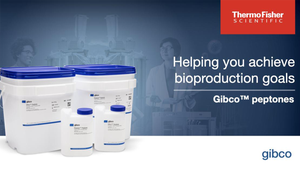- MAb
- Sponsored Content
Ask the Expert: FOLDTEC Refolding of Biopharmaceuticals A Case Study of Recombinant Thrombin
January 13, 2016
Sponsored by Wacker
 with Dr. Andreas Anton and Dr. Sebastian Schuck
with Dr. Andreas Anton and Dr. Sebastian Schuck
Poorly soluble substances form aggregated inclusion bodies (IBs) in microbial cells containing incorrectly and/or incompletely folded target proteins. Wacker Biotech, a full-service contract manufacturer of biopharmaceuticals based on microbial systems, has introduced FOLDTEC refolding technology for bioengineered therapeutic proteins. The proprietary platform uses specifically developed and optimized bacterial strains and a patented, antibiotic-free expression system.
In a BPI webinar on 9 November 2015, Wacker’s director of bioprocess development (Andreas Anton) and head of business development (Sebastian Schuck) demonstrated the potential of this technology with a case study of recombinant expression and in vitro refolding of thrombin, a difficult-to-manufacture protease used to control bleeding.
The Presentations
Schuck introduced FOLDTEC Escherichia coli folding technology for refolding IBs. He described it as “based on three pillars”: proprietary antibiotic-free E. coli strains; a phage-free plasmid system; and rationally designed in vitro refolding.
Next, Anton described the case study comparing FOLDTEC strains with other commonly used E. coli systems. He compared how the strains work in a 150-L fermentor, showing similar growth behavior and similar expression levels. Cultures took <15 h to reach a high optical density (OD) and product titers of several grams per liter.
Anton reviewed protein refolding approaches that start with IBs formed inside E. coli cells. Several methods are available to solubilize those aggregates. He described Wacker’s scalable technique for protein refolding. High protein concentrations promote aggregation, and low concentrations promote folding. “We look for ideal conditions that promote formation of correctly folded and biologically active material.”
Anton showed a 2,000-L stainless steel vessel designed for protein refolding in commercial scale under GMP conditions at Wacker Biotech. “One goal is to reduce the folding volume,” he explained, referring back to the protein concentration issue. “The goal is always to reduce these volumes to appropriate levels, but to keep high refolding yields.”
Next, he explained the parameters that influence refolding efficacy. He began with the E. coli strain, which determines IB quality to buffers and additives used for the folding step. He demonstrated the FOLDTEC advantages with a case study on thrombin, a 37-kDa heterodimer with four disulfide bridges. Reported refolding yields are 4–7%. “We started with these very low yields and tried to find a way to improve efficacy.” Following several approaches, such as screening for additives/buffers, Wacker finds the best options for a given protein.
“We establish an analytical tool to discriminate between folded and unfolded protein. In the case of thrombin, we use high-performance liquid chromatography (HPLC) and an enzymatic activity assay.” After several screening rounds, the team increased yields fivefold while reducing the volume per gram of thrombin by more than four times. That corresponds to a 20-fold increase in productivity.
Questions and Answers
A question-and-answer session followed.
Q: How long does refolding development typically take?
A: Usually it takes 10–15 weeks, depending on the information you already have about your protein and the availability of reference material.
Q: What yields are common for in vitro refolding?
A: That differs among proteins, from 20% up to 80–90%. It depends on protein solubility and disulfide bridges present.
Q: How do you start the process?
A: First, we look at the reference material and develop an analytical method to discriminate between folded and unfolded protein. We also challenge that method with a second analytical method.
Q: How do you validate refolding quality?
A: We always check the biological activity of the variant we are following during folding development.
Q: How many grams of protein can you produce? A: The largest reactor capacity we have is 1,500 L, so we can produce several hundred grams up to the low kilogram range — depending on the protein.
Q: Can you refold proteins that require an N-linked carbohydrate for folding, but not for activity?
A: We haven’t done that before, but it should be no problem to do so.
Q: How much batch-to-batch variation can you expect?
A: Folding is just one part of the manufacturing process. You have the same variability that you have for each biological system. There is no black and white batch-to-batch variability.
Q: Can you get only a bioactive part of the protein folded if you’ve tested it?
A: Yes. That’s no problem if the active part of the protein folds as a stable structure.
Watch the webcast on-demand.
You May Also Like





